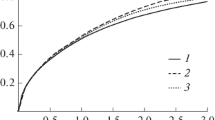Abstract
Based on an analytical solution of the linear equation of heat conduction with mass removal and without it and on the regularity of reaching the stationary heating regime which is established, when the thicknesses of the heated and removed material layers are equal, the authors have proved the S-shaped temperature profile found experimentally near the destroyed surface. It has been noted that the use of the readings of a temperature sensor located in the S-shaped zone of the temperature profile as the boundary conditions can bring about substantial errors in determining thermophysical characteristics using inverse heat-conduction problems.
Similar content being viewed by others
References
O. M. Alifanov, Inverse Problems of Heat Transfer [in Russian], Mashinostroenie, Moscow (1988).
O. M. Alifanov, P. N. Vabishchevich, V. V. Mikhailov, A. V. Nenarokomov, Yu. V. Polezhaev, and S. V. Reznik, Principles of Identification and Designing of Thermal Processes and Systems [in Russian], Logos, Moscow (2001).
O. M. Alifanov, E. A. Artyukhin, and V. P. Rumyantsev, Extremal Methods for Solving Ill-Posed Problems [in Russian], Nauka, Moscow (1988).
E. A. Artyukhin, Optimum planning of experiments in identification of heat-transfer processes, Inzh.-Fiz. Zh., 56, No. 3, 378–382 (1989).
G. A. Frolov, V. V. Pasichnyi, E. I. Suzdal’tsev, and V. S. Tsyganenko, Measurement of temperature fields in specimens of quartz ceramic during surface ablation, Inzh.-Fiz. Zh., 57, No. 2, 313–318 (1989).
G. A. Frolov, A. A. Korol’, V. V. Pasichnyi, V. Ya. Berezhetskaya, E. I. Suzdal’tsev, and V. S. Tsyganenko, Characteristic state-transformation temperatures of quartz glass ceramic with unidirectional heating, Inzh.-Fiz. Zh., 51, No. 6, 932–940 (1986).
G. A. Frolov, The constant of thermal destruction and its role in the processes of heating and entrainment of mass of a material, Inzh.-Fiz. Zh., 77, No. 3, 19–46 (2004).
A. V. Luikov, Heat-Conduction Theory [in Russian], Vysshaya Shkola, Moscow (1967).
A. F. Koryshev and 7. G. A. Frolov, Study of the law of motion of isotherms in an indestructible solid body under different temperature effects, in: Use of the Sun and Other Sources of Radiant Energy in Materials Science [in Russian], Naukova Dumka, Kiev (1983), pp. 137–145.
Yu. V. Polezhaev and 7. G. A. Frolov, Influence of thermal conductivity of a material on an unsteady heat-removal parameter, Inzh.-Fiz. Zh., 62, No. 4, 546–551 (1992).
Author information
Authors and Affiliations
Additional information
__________
Translated from Inzhenerno-Fizicheskii Zhurnal, Vol. 78, No. 6, pp. 49–55, November–December, 2005.
Rights and permissions
About this article
Cite this article
Frolov, G.A., Baranov, V.L. Temperature profile in the stationary and nonstationary regimes of heating and mass removal of low-thermal-conductivity materials. J Eng Phys Thermophys 78, 1096–1103 (2005). https://doi.org/10.1007/s10891-006-0039-8
Received:
Revised:
Issue Date:
DOI: https://doi.org/10.1007/s10891-006-0039-8




